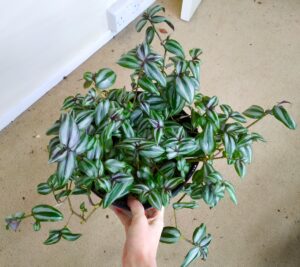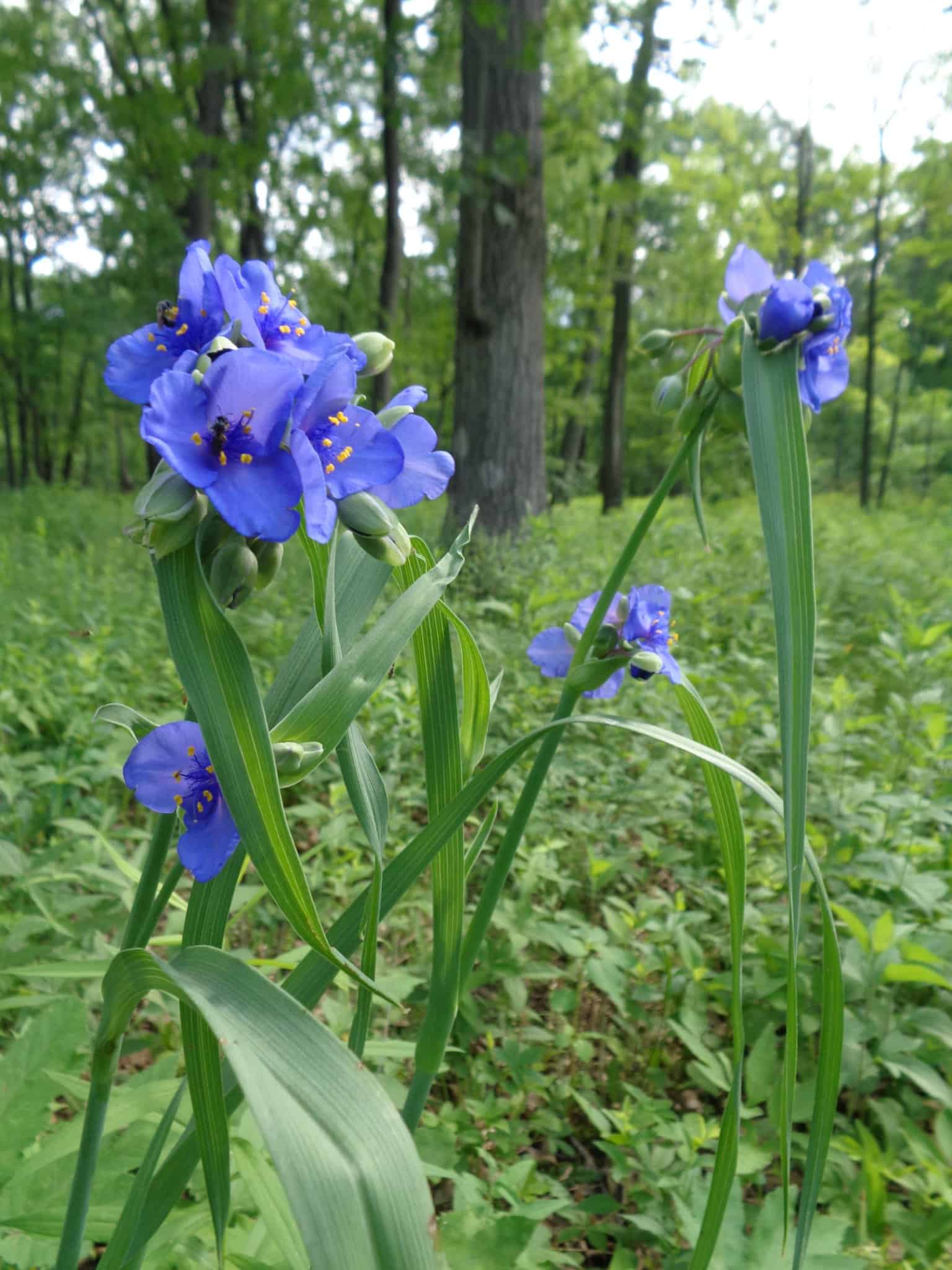Tradescantia is a herbaceous perennial wildflower with beautiful flowers and equally enthralling foliage.
After reading this article, I hope you can reach a conclusion and decide the variety for you. So, jump right in.
Table of Contents Show
10 Tradescantia Varieties With Pictures
Tradescantia is a popular plant that has almost 75 varieties you can choose from.
Almost all the Spiderwort varieties have variegated, succulent-like foliage with flowers that range from pink and white to lavender.
Now, let us dwell deep into this matter and look at the stunning Tradescantia varieties.
1. Tradescantia Zebrina
Tradescantia zebrina was previously known as ‘Zebrina pendula’ and currently goes by the common name ‘Inchplant.’
This exotic plant can grow anywhere from 6 to 9 inches tall but can spread as much as it likes.

Its oval-shaped leaves are white, green, and gray, and the underside of the leaves showcases purple color.
They can be grown outside in USDA zones 9 to 11.
Zebrina also offers you the privilege of choosing from its various cultivars like Multi-color discolor, Quadricolor, Silver Plus, Red Gem, and Burgundy.
If you want one of these, you can order it here.
Moreover, Tradescantia zebrina produces white to lavender flowers with boat-shaped three petals and prominent yellow anthers.
If you have already got a Tradescantia zebrina, and it is showing yellow leaves, read our article on Tradescantia Zebrina turning yellow.
2. Tradescantia Chrysophylla
Tradescantia chrysophylla is a popular variety with the common name ‘Baby bunny bellies’ because it feels soft when you touch it.
They are also known by other names, such as oyster plants, cradle lilies, spider lilies, and cradle lilies.
Native to Brazil, Tradescantia chrysophylla grows as a terrestrial or an epiphyte plant in shaded forests.
Under ideal conditions, this plant will grow to a height of 6 to 12 inches tall, while its stems can trail up to 24 inches.

They boast a fuzzy set of olive to gray-green leaves with a purple-colored underside. Moreover, they produce lavender and white-colored inconspicuous flowers.
Its unique foliage will compel you to buy it. You can buy this stunning plant on Amazon.
3. Tradescantia Sillamontana
Tradescantia sillamontana, commonly known as Cobweb spiderwort, White velvet, Teddy bear vine, and other fancy names, is an exotic variety of Tradescantia.
This plant can grow up to the size of 12 inches tall and can go up to 16 to 20 inches wide.

The leaves are greyish-green and covered with silvery-white hairs and purple-colored undersides.
Additionally, they produce purplish-pink flowers that grow in clusters and can live for up to a month.
You can choose from two cultivars of this plant: White buzz and variegata. You can buy its amazing varieties on Amazon.
4. Tradescantia Blossfeldiana
Many people know Tradescantia blossfeldiana as ‘Bubblegum’ or ‘Lilac.’
Native to Brazil and Northern Argentina, Tradescantia blossfeldiana is a fast grower that can grow up to a length of 3 feet and a width of 1.5 feet.

They boast unique glossy leaves that are green and have cream, lilac, or pink variegations.
Additionally, they grow small flowers with three pink petals and purple sepals.
Some of its cultivars are red hill, Lilac, Bubblegum, Pink Furry, and variegata Aurea. You can find these plants on Amazon.
Some vendors incorrectly referred to Tradescantia blossfeldiana as Tradescantia fluminensis Tricolor “Nanouk.”
Because one of the blossfeldiana varieties (cerinthoides variegata) looks quite similar to fluminensis.
5. Tradescantia Pallida
Tradescantia pallida are known by their common name, ‘Purple Heart,’ which derives from the plant’s eye-catching purple foliage.
They boast elongated purple leaves and produce sterile three-petalled flowers in either white, pink, or purple.
The plant size is short as it only reaches the size of 8 inches. However, the trailing stems can grow up to 18 inches.

The original name of the plant was Setcreasea pallida which Joseph Nelson Rose gave in 1911.
However, D.R. Hunt reclassified the plant in the Tradescantia genus in 1975, giving its name Tradescantia pallida.
It offers you a lot of cultivars like Pale Puma, Purple Heart, and Pink Stripes to choose from. You can buy Tradescantia pallida on Amazon.
6. Tradescantia Andersonia
Tradescantia andersonia goes by the common names of Concord Grape and Snowcap.
Unlike most of its other counterparts, this plant can amass the size of about 18 inches in height and width with proper care.

They boast bluish-green, lance-shaped leaves with parallel venation. Their flowers are showy with three white petals and yellow stamens.
It has a cultivar with a beautiful name, ‘Beautiful Bride,’ you can get your hands on. Many online sites sell this variety of Tradescantia.
7. Tradescantia Fluminensis
Tradescantia fluminensis is also known by other common names such as river spiderwort, small leaf spiderwort, wandering jew, and wandering trad.
Although its common name, ‘Wandering jew,’ may offend some people, its beautiful foliage and flowers will not offend anyone.
Tradescantia fluminensis boasts oval, shiny pointed leaves that can grow up to 6 inches tall, but their stems can increase their width and reach up to 2 feet.

They produce white, clustered flowers with three petals, three sepals, with a detached anther.
Moreover, it has two cultivars (Aureovariegata and Lavender) you can choose from. You can buy this variety on Amazon.
8. Tradescantia Ohiensis
Tradescantia ohiensis’s common name’ Ohio spiderwort’ comes from the plant’s scientific name.
Unlike other varieties, this plant can grow to a massive height of up to 3 feet and a width of 2 feet.
Tradescantia ohiensis boasts dark, bluish-green leaves that are shaped like grass strands.

Moreover, they produce flowers that are rose-blue and have three beautiful petals.
In addition, they have up to eight nodes of branched and upright bluejacket stems that are tinged purple.
Tradescantia ohiensis doesn’t have any recognized cultivars. You can buy this stunning variety from Amazon.
9. Tradescantia Albiflora
Tradescantia albiflora, commonly known as ‘albo-vittata’, is sure to charm you with its aesthetic beauty.
This plant can grow to a height ranging from 6 to 9 inches and spread up to two inches.

The leaves are shiny and green, and the underside of the leaves is purple. Additionally, they produce beautiful flowers with three white petals sporadically throughout the year.
Albiflora is also known as Quicksilver and has a cultivar, ‘Nanouk.’ Grab one of these beauties from Amazon.
10. Tradescantia Spathacea
Unlike other varieties, Tradescantia spathacea has a unique common name out of all the types. It is also called ‘Moses-in-the-cradle’.
Tradescantia spathacea is a semi-epiphytic herbaceous shrub that can reach a height of about 12 inches, and the leaves share the same growth length.

Tradescantia spathacea has distinctive lance-shaped foliage with a dark to metallic green top and purple undersides.
Moreover, they produce white flowers with three petals and boat-shaped bracts all year long that grow at leaf axils.
You can also choose from two plant cultivars, Moses in the cradle and Sitara’s Gold. You can buy these amazing varieties from Amazon.
Tips to Care for Tradescantia Plants
One of the many benefits of getting this plant is that all members of the Tradescantia genus can thrive with little care.
If you have one or more Tradescantia varieties, follow the care requirements below to get better yields.
- Keep the plants in bright but indirect sunlight for about 8 hours daily.
- Plant them in all-purpose, well-draining soil in a hanging basket.
- Keep the plants constantly moist by watering them weekly in the summer. Reduce the watering frequency in winter.
- Maintain a warm temperature of 60 to 80°F and humidity higher than normal household humidity.
- Dilute the standard houseplant fertilizer to half its strength and feed the plant once every month during spring and summer.
- You can occasionally pinch the flowers if you want the plant to focus its energy on the foliage.
- Be on guard for spider mites and aphids. Spray neem oil on the foliage if you witness any pests.
You can easily grow healthy Spiderwort varieties at home as they require minimum care.
Conclusion
Spiderwort varieties can easily be anyone’s favorite, thanks to their beautiful foliage and equally charming flowers.
The only complicated thing about this plant is its name, which also has a solution, its common name ‘spiderwort.’
Happy gardening!


